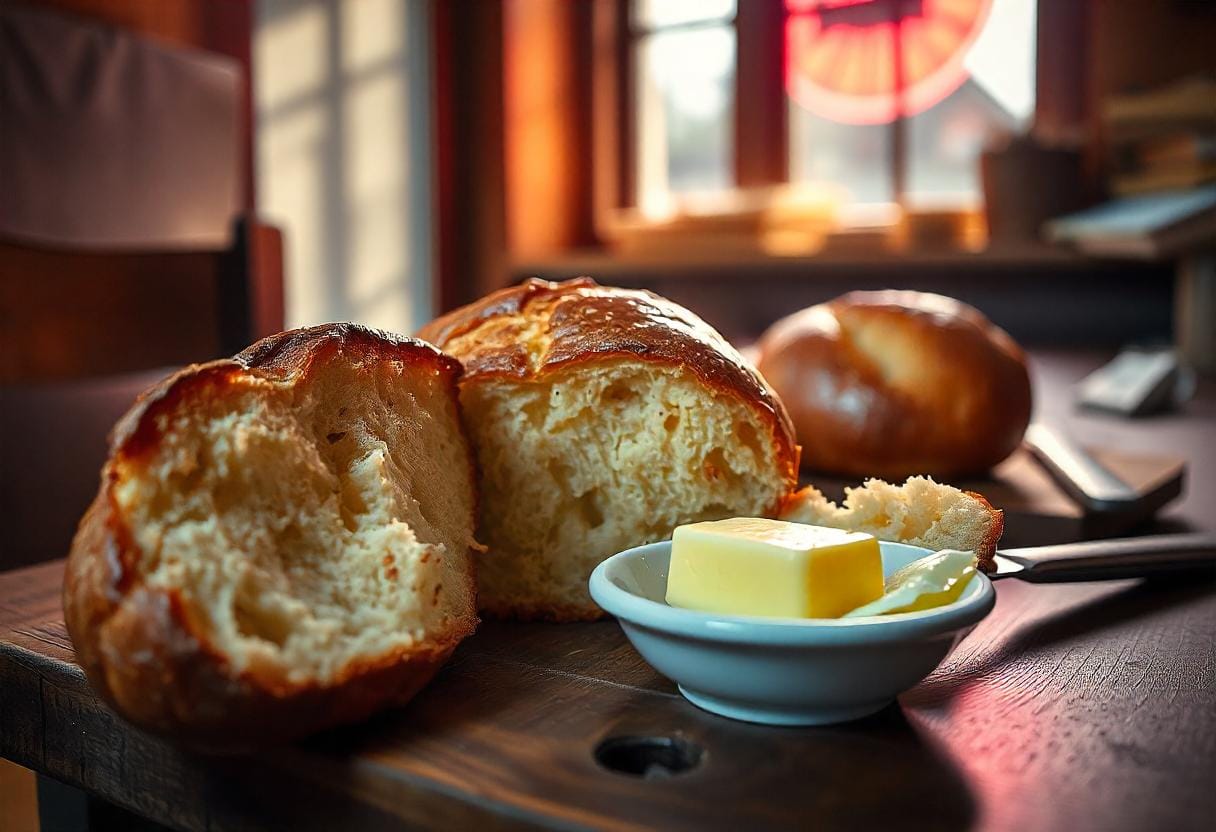Table of Contents
How is brioche eaten in France? The French enjoy this rich, buttery bread in numerous delightful ways. Brioche – a name that evokes the rich, buttery, and sweet aroma of freshly baked bread – is much more than a mere loaf in France. It’s a cultural icon, enjoyed in countless ways across the country
Whether in France or at home, knowing how to enjoy brioche lets you embrace this delicious tradition. So, let’s unravel the secret of brioche and discover its many forms!
How is Brioche Eaten in France?: Its Importance in French Cuisine
Brioche isn’t just a popular type of bread in France; it’s interwoven with French history and culture. For centuries, brioche has been a festive treat, enjoyed at breakfast, or used in indulgent desserts. With its buttery, soft, and slightly sweet texture, it has a unique place in French culinary traditions.
While you might associate brioche with French pastries like croissants or pain au chocolat, brioche’s distinct texture—thanks to a high butter and egg content—makes it stand out. It’s the perfect balance of bread and cake, making it a versatile addition to any meal. From slices toasted in butter to served alongside your morning coffee, brioche is more than just a loaf of bread—it’s a statement of French indulgence.
What is Brioche? Understanding the Basics
Before we dive into how brioche is enjoyed, let’s break down what brioche is and how it’s made. Brioche is a light, sweet yeast bread that’s made using a dough enriched with butter, eggs, sugar, and sometimes milk. Unlike regular bread, brioche’s dough is richer and denser, resulting in its soft, fluffy texture.
The History and Origin of Brioche
Brioche originated in Normandy, France, with its name derived from the French verb ‘brier,’ meaning to knead or beat the dough. It was traditionally considered a luxury bread due to the generous amounts of butter and eggs in the dough.
Brioche has historical roots that can be traced back to the 16th century and was originally served at royal feasts. Today, it remains a beloved staple in French households and bakeries, with regional variations adding unique twists to the basic recipe.
How is Brioche Eaten in France: Popular Traditional Methods
So, how do the French enjoy their brioche? The beauty of brioche lies in its versatility—you can enjoy it sweet or savory depending on your taste. Let’s take a look at some of the most popular ways to eat brioche in France.
Brioche for Breakfast: A French Tradition
In France, breakfast is not just a quick meal—it’s an experience. And what better way to start your day than with a warm, buttery slice of brioche? It’s often served with a cup of café au lait or freshly brewed coffee. The slightly sweet and airy texture of brioche pairs perfectly with a morning drink and provides the energy needed to kick-start the day.
For an indulgent twist, transform your brioche into Brioche French Toast Casserole for a rich and satisfying breakfast
Brioche may be served simply with butter and a generous spread of jam or honey for sweetness. Alternatively, it might be served with Nutella, a favorite chocolate-hazelnut spread, for a more indulgent treat. In fact, it’s not unusual for French children to have brioche with Nutella for breakfast—considered the ultimate treat for many!

Brioche in French Pastries: More Than Just Bread
Pain au lait and brioche à tête are two well-known examples of how brioche dough can be transformed into delicious pastries. Brioche à tête, in particular, is a type of brioche that has a distinctive shape with a small « head » on top, often served as a dessert or special snack.
You’ll also find brioche used as a base for fruit tarts or filled with pastry cream, further showcasing its versatility. This use of brioche in French pastries highlights how it can be more than just a loaf—it’s a delicious canvas for other ingredients.
Brioche as a Snack: Perfect with Coffee or Tea
In France, snacking is an art form. Instead of heavy, processed snacks, the French love light, indulgent treats that are simple yet satisfying. Brioche is a popular snack choice, often eaten in the afternoon as a way to satisfy a sweet craving.
Imagine this: you’re sitting at a French café, enjoying the peaceful atmosphere, and you order a slice of freshly baked brioche with your tea. There’s something about the softness of the brioche paired with a warm cup of tea or coffee that feels luxurious yet comforting. Whether you’re in France or recreating this experience at home, brioche as a snack is the perfect way to indulge in a French tradition.
How is Brioche Eaten in France as Part of French Desserts
While brioche is often eaten as bread, it plays a major role in French desserts as well. Its soft and slightly sweet texture makes it a delicious base for many classic French sweets.
Brioche in French Toast: A Richer Take on the Classic
While French toast is often made with regular bread, using brioche can make it even more indulgent. Brioche French toast has a richer, more buttery flavor, making it a luxurious breakfast or dessert option. The thick slices of brioche soak up the custard mixture perfectly, giving it a soft, custardy interior and a crispy exterior.
Brioche and French toast go hand in hand, but are they the same? Find out in this comparison of brioche and French toast
This twist on the traditional French toast recipe is a favorite in many French homes and restaurants, showcasing just how versatile brioche is in the world of desserts.

Using Brioche in Bread Puddings and Cakes
Another way to use brioche in French desserts is by incorporating it into bread puddings or cakes. The richness of the bread creates a decadent, indulgent dessert that is perfect for special occasions or as a treat after dinner. Brioche bread pudding has a velvety texture that is rich without being overly heavy, and it can be flavored with ingredients like vanilla, chocolate, or orange zest for an extra layer of flavor.
Block Quote:
« Brioche is not just bread in France—it’s an experience. Whether enjoyed at breakfast, as part of a dessert, or in a savory dish, brioche elevates every moment. »
How is Brioche Eaten in France in Savory Dishes and Meals
While brioche is typically associated with sweet breakfasts and desserts, it also plays a role in many savory dishes in France. The richness of brioche’s texture makes it perfect for balancing savory flavors, and it can be used in a variety of ways beyond the usual sweet pairings.
Brioche in Savory Sandwiches
One of the most classic ways to enjoy brioche in a savory setting is by using it for sandwiches. Brioche’s slightly sweet flavor complements savory fillings beautifully, making it an excellent choice for luxurious sandwiches.
Brioche isn’t just for breakfast! Discover why brioche buns are a perfect choice for gourmet sandwiches and hot dogs.
If you’re curious how brioche compares to other enriched breads, check out this guide on the difference between brioche and milk bread.

Brioche as an Accompaniment to French Soups and Stews
In some regions of France, brioche is used as a side dish to soups and stews. The rich, soft texture of brioche makes it an ideal accompaniment to the hearty flavors of French soups like French onion soup or pot-au-feu. The bread’s slight sweetness offers a balanced contrast to the savory, rich broths, and it’s often dipped in the soup to soak up all the delicious flavors.
Brioche can also be served alongside stews and casseroles, providing a soft, comforting texture that pairs well with the depth of these dishes. In France, bread, including brioche, plays a significant role in soaking up the sauce, adding another layer to the meal.
How is Brioche Eaten in France: Traditional Serving Methods
Brioche is such a versatile bread that it can be served in a variety of ways depending on the occasion. Whether as part of a morning routine, dessert, or even in savory meals, brioche has earned a spot at the French table for its richness and indulgence.
Brioche with Butter and Jam: A Simple Delight
One of the simplest and most traditional ways the French enjoy brioche is by spreading a generous amount of butter on a warm slice of brioche and then topping it with homemade jam or honey. It’s the kind of comforting breakfast you’ll find in homes across France. The rich, buttery texture of the brioche, combined with the sweetness of the jam, creates a flavor that’s not overly sweet, just perfectly balanced.
This type of breakfast is especially popular in small French cafés and is often accompanied by a hot coffee or café au lait. It’s the ideal way to start the day, providing just the right amount of sugar to kickstart your morning without being overwhelming.
Brioche as an Elegant Dessert Base in French Restaurants
While brioche is often seen as a humble loaf of bread, in French restaurants, it is often used as the base for elegant desserts. You might find brioche served in sophisticated dessert forms like bread puddings or as the foundation of a French toast soufflé. In these cases, the rich, buttery brioche enhances the dessert with a soft, flavorful base that’s not too heavy but still indulgent.
A prime example is brioche à tête, a small, dome-shaped brioche that is often used as the foundation of luxurious desserts in fine dining. This version of brioche is sometimes filled with fruit or pastry cream, creating a delightful treat that’s rich in flavor yet light in texture.
Common Problems When Eating Brioche and How to Solve Them
Brioche may seem like a foolproof bread, but there are a few common problems people face when eating or preparing it. Let’s look at these issues and explore some solutions.
What to Do if Brioche Gets Stale?
Over time, brioche can become stale and lose its softness. If you find yourself with stale brioche, don’t throw it out just yet! There are several ways to revive or use up stale brioche.
Solution:
One of the best ways to use stale brioche is to make French toast. The custard mixture helps soak the bread, bringing back its softness and moisture. Another solution is to toast it lightly, which gives it a crisp texture perfect for serving with jam or even making a savory sandwich.
How to Properly Store Brioche for Freshness
To keep your brioche fresh for a longer period, proper storage is essential. Storing it improperly can cause it to dry out quickly or even get moldy.
Solution:
Brioche should be stored in an airtight container or wrapped in plastic wrap to keep it fresh. If you plan on keeping it for longer than a few days, it’s best to freeze it. Freezing brioche helps maintain its moisture and softness, so you can simply thaw it when ready to enjoy.
Creative Recipes to Try with Brioche
Brioche is incredibly versatile, and there are countless ways to incorporate it into meals beyond just breakfast. Here are a few ideas to get creative with your brioche:
Brioche Breakfast Ideas: Creative Ways to Enjoy It
- Brioche Breakfast Casserole: Layer brioche with custard and top with fruit, then bake to create a delicious breakfast casserole. It’s like French toast in a dish!
- Brioche with Fresh Berries: Top toasted brioche with fresh berries, whipped cream, and a drizzle of honey for a light and fruity breakfast option.
- Brioche French Toast: Prepare classic French toast with thick slices of brioche, then top with powdered sugar, maple syrup, and a few slices of fresh fruit.
Brioche Recipes for Special Occasions
- Brioche Buns for Burgers: Use brioche buns to make the most indulgent, rich burgers. The slightly sweet flavor of brioche pairs perfectly with juicy meat and melted cheese.
- Brioche Pudding: Transform leftover brioche into an amazing dessert by using it in a bread pudding. The bread soaks up the custard, creating a rich, creamy dish.
Frequently Asked Questions (FAQs) About Brioche in France
1. Can I eat brioche every day in France?
Yes! While brioche is often considered a luxurious treat due to its rich texture and ingredients, it’s commonly enjoyed daily in France, especially as part of breakfast. However, like any indulgent food, it’s best enjoyed in moderation to maintain a balanced diet.
2. Is brioche always served fresh in France?
Typically, brioche is served fresh, especially in French bakeries. It’s baked daily to ensure that customers get the best quality. If you buy brioche from a bakery, you can expect it to be soft, fluffy, and fresh. However, leftover brioche can be stored and used in dishes like French toast or bread pudding.
3. Can brioche be used for savory dishes in France?
Absolutely! Although brioche is most commonly associated with sweet dishes, it’s also used in savory French recipes. For example, brioche is sometimes used for luxurious sandwiches or served alongside soups and stews. The slightly sweet and buttery flavor of brioche pairs wonderfully with rich, savory fillings, making it a versatile ingredient in French cuisine.
4. How long does brioche last before it goes stale?
Brioche tends to stale quickly due to its high butter and egg content. It’s best to eat it within 1-2 days of purchase for maximum freshness. If you want to keep it longer, you can freeze brioche. To reheat, you can thaw it at room temperature or warm it up in the oven for a few minutes to bring back its soft texture.
5. What is the best way to store brioche to keep it fresh?
To keep brioche fresh, store it in an airtight container or wrap it in plastic wrap. If you plan to keep it for a longer period, it’s best to freeze it. Freezing helps preserve the softness and moisture of brioche. Just make sure to thaw it gently when ready to enjoy.
6. Is brioche gluten-free?
No, brioche is not gluten-free. It’s made with wheat flour, which contains gluten. However, there are some bakeries that may offer gluten-free versions of brioche, although they are less common. If you follow a gluten-free diet, check the label or inquire about gluten-free alternatives at bakeries.
7. Can I make brioche at home?
Yes! While brioche might seem like a complex bread to make, it’s definitely doable at home. The key is to knead the dough properly and allow it to rise. You’ll need butter, eggs, flour, and yeast to create the rich dough. Patience is important as the dough needs to rise twice, but the result is worth the wait! If you’re interested, there are plenty of online recipes and tutorials that can guide you step by step.
8. How do I know if my brioche is baked properly?
Brioche should have a golden-brown crust and a soft, fluffy interior. When you tap the bottom of the loaf, it should sound hollow, indicating that it’s fully baked. If the inside feels too dense or heavy, it may need a little more time in the oven. It’s important to keep a close eye on it as baking times can vary depending on the size and shape of the loaf.
9. Is brioche high in calories?
Yes, brioche is relatively high in calories due to the butter, eggs, and sugar used in the recipe. One slice can contain around 150-200 calories. While it’s delicious and indulgent, it’s best enjoyed as a treat rather than a daily habit if you’re concerned about calorie intake. Enjoy it in moderation as part of a balanced diet.
10. Can brioche be used to make French toast?
Absolutely! In fact, brioche makes an amazing base for French toast. Its rich, buttery texture soaks up the custard mixture perfectly, resulting in a crispy, golden-brown exterior and a soft, custardy interior. If you’re making French toast, brioche is definitely a top choice for an extra indulgent treat.
Conclusion
Brioche holds a special place in French culture and cuisine. From sweet breakfasts to savory dishes and desserts, this versatile bread is loved by the French for its rich flavor and soft, buttery texture. Whether you enjoy it fresh out of the bakery or use it in a recipe, brioche is always a treat worth savoring. Keep these tips in mind, and you’ll be able to fully enjoy the wonders of brioche just like the French!

